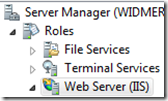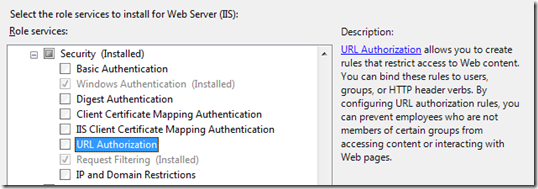A common requirement in our projects is to select a GridView row and pass multiple values of the selected row to another page. I recently got a request from a few readers who wanted an article on this. In this article, we will explore how simple it is to achieve this requirement.
I assume you have some basic understanding of the GridView and how to bind it to a Data Source control. The Hyperlink control added to the GridView makes it quiet easy to select a row and send single/multiple values to a different page through the URL. Let us see how:
Step 1: Create a new ASP.NET website. Drag and drop a SqlDataSource Control to the page and use the wizard to connect to the Northwind database. Select the CustomerId, CompanyName, ContactName, Address and City from the Customers table. The wizard will also prompt you to save the connection string in the web.config file. Choose to do so. The design code will look similar to the following:
<asp:SqlDataSource ID="SqlDataSource1" runat="server" ConnectionString="<%$ ConnectionStrings:NorthwindConnectionString %>"
SelectCommand="SELECT [CustomerID], [CompanyName], [ContactName], [Address], [City] FROM [Customers]">
</asp:SqlDataSource>
An entry will be added to the web.config file as shown below:
<connectionStrings>
<add name="NorthwindConnectionString" connectionString="Data Source=(local);Initial Catalog=Northwind;Integrated Security=True"providerName="System.Data.SqlClient"/>
</connectionStrings>
Step 2: Now add a GridView control to the page and using the smart tag, select the DataSource to be SqlDataSource1 in the GridView tasks panel. Using the same panel, click on the Enable Paging and Enable Sorting checkboxes. The source will look similar to the following. Observe that the DataKeyNames is set to ‘CustomerId’, that is the primary key of the Customers table.
<asp:GridView ID="GridView1" runat="server" AutoGenerateColumns="False" DataKeyNames="CustomerID"
DataSourceID="SqlDataSource1" AllowPaging="True" AllowSorting="True">
<Columns>
<asp:BoundField DataField="CustomerID" HeaderText="CustomerID" ReadOnly="True" SortExpression="CustomerID" />
<asp:BoundField DataField="CompanyName" HeaderText="CompanyName" SortExpression="CompanyName" />
<asp:BoundField DataField="ContactName" HeaderText="ContactName" SortExpression="ContactName" />
<asp:BoundField DataField="Address" HeaderText="Address" SortExpression="Address" />
<asp:BoundField DataField="City" HeaderText="City" SortExpression="City" />
</Columns>
</asp:GridView>
Step 3: We will now add another page in our project. In the Solution Explorer, right click the project > Add New Item > Web Form > Rename it to ‘CustomerDetails.aspx’.
Step 4: Go back to Default.aspx and add two hyperlink fields. We will see how to pass a single value as well as multiple values using the two hyperlink fields.
Single Value:
Add the following hyperlink control after the <Columns> tag in the GridView as shown below:
<Columns>
<asp:HyperLinkField DataNavigateUrlFields="CustomerID" DataNavigateUrlFormatString="CustomerDetails.aspx?CID={0}" Text="Pass Single Value" />
Multiple Values:
Just below the first hyperlink field, add another hyperlink field as shown below:
<asp:HyperLinkField DataNavigateUrlFields="CustomerID, CompanyName, ContactName, Address, City" DataNavigateUrlFormatString="CustomerDetails.aspx?CID={0}&CName={1}&ContactName={2}&Addr={3}&City={4}" Text="Pass Multiple Values" />
In the source code shown above, we are using the hyperlink field and setting some properties that will make it extremely easy to pass values to a different page. The 'DataNavigateUrlFields' sets the names of the fields, that is to be used to construct the URL in the HyperLinkField. In the first hyperlink, since we are passing only a single value, the DataNavigateUrlFields contains only CustomerID. However in the second hyperlink, since there are multiple values to be passed, DataNavigateUrlFields contains all the names of the fields that are to be passed as query string to CustomerDetails.aspx
Similarly, the 'DataNavigateUrlFormatString' sets the string that specifies the format in which the URL is to be created. The 'Text' property represents the text that will be displayed to the user. The entire source code will look similar to the following:
<body>
<form id="form1" runat="server">
<div>
<asp:SqlDataSource ID="SqlDataSource1" runat="server" ConnectionString="<%$ ConnectionStrings:NorthwindConnectionString %>"
SelectCommand="SELECT [CustomerID], [CompanyName], [ContactName], [Address], [City] FROM [Customers]">
</asp:SqlDataSource>
</div>
<asp:GridView ID="GridView1" runat="server" AutoGenerateColumns="False" DataKeyNames="CustomerID"
DataSourceID="SqlDataSource1" AllowPaging="True" AllowSorting="True">
<Columns>
<asp:HyperLinkField DataNavigateUrlFields="CustomerID"
DataNavigateUrlFormatString="CustomerDetails.aspx?CID={0}"
Text="Pass Single Value" />
<asp:HyperLinkField DataNavigateUrlFields="CustomerID, CompanyName, ContactName, Address, City"
DataNavigateUrlFormatString="CustomerDetails.aspx?CID={0}&CName={1}&ContactName={2}&Addr={3}&City={4}"
Text="Pass Multiple Values" />
<asp:BoundField DataField="CustomerID" HeaderText="CustomerID" ReadOnly="True" SortExpression="CustomerID" />
<asp:BoundField DataField="CompanyName" HeaderText="CompanyName" SortExpression="CompanyName" />
<asp:BoundField DataField="ContactName" HeaderText="ContactName" SortExpression="ContactName" />
<asp:BoundField DataField="Address" HeaderText="Address" SortExpression="Address" />
<asp:BoundField DataField="City" HeaderText="City" SortExpression="City" />
</Columns>
</asp:GridView>
</form>
</body>
Step 5: The last step is to retrieve the query string variables from the URL in the CustomerDetails.aspx page. Add the following code for that:
C#
protected void Page_Load(object sender, EventArgs e)
{
string cid = Request.QueryString["CID"];
string cname = Request.QueryString["CName"];
string contactName = Request.QueryString["ContactName"];
string address = Request.QueryString["Addr"];
string city = Request.QueryString["City"];
}
Set a breakpoint at the Page_Load method of the CustomerDetails.aspx. Run the application and click on either the ‘Pass Single Value’ or ‘Pass Multiple Values’ hyperlink to pass values to the CustomerDetails.aspx page. Using the breakpoint, observe the values of the selected row being passed to the CustomerDetails page.
Tip 14: Displaying Empty Data in a GridView
When there are no results returned from the GridView control’s data source, the short and simple way of displaying a message to the user, is to use the GridView’s EmptyDataText property.
<asp:GridView ID="GridView1" runat="server" AutoGenerateColumns="False" DataKeyNames="CategoryID"
DataSourceID="SqlDataSource1" EmptyDataText="No data available"
ShowFooter="true" AllowPaging="True" AllowSorting="True"
PageSize="5" OnRowDataBound="GridView1_RowDataBound">
Note: You can also add style to the EmptyDataText by using the EmptyDataRowStyle property. Tip 15: Displaying an Image in case of Empty Data in a GridView
As an alternative to using the EmptyDataText property, if you need to display an image or any HTML/ASP.NET control, you can use the EmptyDataTemplate. In this snippet below, we are using the image control in the <EmptyDataTemplate> to display an image.
<asp:GridView ID="GridView1" runat="server" AutoGenerateColumns="False" DataKeyNames="CategoryID"
DataSourceID="SqlDataSource1" ShowFooter="true" AllowPaging="True" AllowSorting="True"
PageSize="5" OnRowDataBound="GridView1_RowDataBound">
<EmptyDataTemplate>
<asp:Image id="imgNoData"
ImageUrl="~/images/NoDataFound.jpg"
AlternateText="No data found"
runat="server"/>
</EmptyDataTemplate>
Tip 16: Highlight a Row in GridView without a PostBack
Selecting a row in the GridView causes a postback. In order to highlight a row in the GridView, you have to set the ‘SelectedRowStyle’ property which takes effect when the postback occurs. In this article, we will see how to highlight a row without causing a postback.
We will be using the RowCreated event of the GridView. A GridViewRow object is created for each row in the control before the GridView is rendered. Whenever a row in the GridView gets created, the RowCreated event is fired. Using this event, we can customize the behavior of the GridView. For e.g.: adding client script to the row or customizing the content of the row. Let us see an example where we will be adding some client script to the GridView. I assume that you have some experience of creating data sources and binding controls to it.
Perform the following steps:
Step 1: Create an asp.net website. In the Default.aspx page, add a GridView and a SqlDataSource control to it.
Step 2: Configure the connection of SqlDataSource to point to the Northwind database. Create query for the Select command to fetch records from the Customer table. The resultant code will look similar to the one given below:
<asp:SqlDataSource ID="SqlDataSource1" runat="server" ConnectionString="<%$ ConnectionStrings:NorthwindConnectionString %>"
SelectCommand="SELECT [CustomerID], [CompanyName], [ContactName], [ContactTitle], [Address], [City] FROM [Customers]">
</asp:SqlDataSource>
The web.config will look similar to the following
<connectionStrings>
<add name="NorthwindConnectionString" connectionString="Data Source =.;Integrated Security = SSPI; Initial Catalog=Northwind;"/>
</connectionStrings>
Step 3: Once the SqlDataSource has been configured, bind the GridView to this data source. Also set ‘AllowPaging’ and ‘AllowSorting’ to true. The mark up will look similar to the following:
<body>
<form id="form1" runat="server">
<div>
<asp:GridView ID="GridView1" runat="server" AutoGenerateColumns="False" DataKeyNames="CustomerID" DataSourceID="SqlDataSource1" AllowPaging="True" AllowSorting="True">
<Columns>
<asp:BoundField DataField="CustomerID" HeaderText="CustomerID" ReadOnly="True" SortExpression="CustomerID" />
<asp:BoundField DataField="CompanyName" HeaderText="CompanyName" SortExpression="CompanyName" />
<asp:BoundField DataField="ContactName" HeaderText="ContactName" SortExpression="ContactName" />
<asp:BoundField DataField="ContactTitle" HeaderText="ContactTitle" SortExpression="ContactTitle" />
<asp:BoundField DataField="Address" HeaderText="Address" SortExpression="Address" />
<asp:BoundField DataField="City" HeaderText="City" SortExpression="City" />
</Columns>
</asp:GridView>
</div>
<asp:SqlDataSource ID="SqlDataSource1" runat="server" ConnectionString="<%$ ConnectionStrings:NorthwindConnectionString %>"
SelectCommand="SELECT [CustomerID], [CompanyName], [ContactName], [ContactTitle], [Address], [City] FROM [Customers]">
</asp:SqlDataSource>
</form>
</body>
Step 4: Now switch to the design mode and select the GridView. Go to the properties window (F4) and click on the lightning like bolt to display the events of the GridView. Double click the RowCreated event to add the event. The mark up will look similar to the following
<asp:GridView ID="GridView1" runat="server" AutoGenerateColumns="False" DataKeyNames="CustomerID" DataSourceID="SqlDataSource1" AllowPaging="True" AllowSorting="True" OnRowCreated="GridView1_RowCreated">
...
</asp:GridView>
Step 5: In the code behind of Default.aspx, add the following code to the RowCreated event handler
protected void GridView1_RowCreated(object sender, GridViewRowEventArgs e)
{
e.Row.Attributes.Add("onMouseOver", "this.style.background='#eeff00'");
e.Row.Attributes.Add("onMouseOut", "this.style.background='#ffffff'");
}
As you are already aware that the GridView is rendered as a HTML table and each row as <TR>. In the code shown above, we are using the Attributes property of the AttributeCollection to add extra properties to the <TR> element. The onMouseOver and the onMouseOut events are added that enable the row to change its color whenever the mouse is over a particular row.
Run the application and see the color of the rows changing, that too without a postback!!
Well that was a quick overview of the RowCreated event. You can also use the same event to find the index of the row clicked. Just use e.Row.DataItemIndex.ToString() to retrieve the selected row index information.
Tip 17: How to Bind a List<> to a GridView
Let us see how to bind a List<> to a GridView. We assume that the ‘AutoGenerateColumns’ = True. We will create a class called Employees and bind it to the GridView with the help of a List<>.
Create a class called ‘Employees’
C#
public class Employee
{
private string enm;
private int ageofemp;
private string department;
public string EName
{
get
{
return enm;
}
set
{
enm = value;
}
}
public int Age
{
get
{
return ageofemp;
}
set
{
ageofemp = value;
}
}
public string Dept
{
get
{
return department;
}
set
{
department = value;
}
}
public Employee(string ename, int age, string dept)
{
this.enm = ename;
this.ageofemp = age;
this.department = dept;
}
}
Bind the ‘Employee’ data to the GridView using a List<>
C#
protected void Page_Load(object sender, EventArgs e)
{
System.Collections.Generic.List<Employee> emp = new System.Collections.Generic.List<Employee>();
emp.Add(new Employee("Jack", 22, "Marketing"));
emp.Add(new Employee("Anna", 28, "Advertising"));
emp.Add(new Employee("Linra", 23, "Advertising"));
emp.Add(new Employee("Jacob", 44, "Production"));
emp.Add(new Employee("Zinger", 28, "PPC"));
GridView1.DataSource = emp;
GridView1.DataBind();
}
Well that was a quick overview of some of the most frequently used features of the GridView control. I hope you liked the article and I thank you for viewing it.




